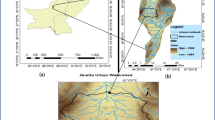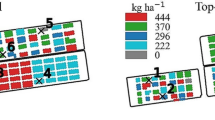Abstract
The study compares the prediction performances of evapotranspiration by the FAO56 Penman–Monteith method and the pan evaporation method using the artificial neural network. A backpropagation neural network was adopted to determine the relationship between meteorological factors and evapotranspiration or evaporation. The evapotranspiration in the ChiaNan irrigated area of Tainan was considered. Weather data compiled by Irrigation Experiment Station of ChiaNan Irrigation Association were the input layer variables, including (1) the highest temperature, (2) the lowest temperature, (3) the average temperature, (4) the relative humidity, (5) the wind speed, (6) hours of sunlight, (7) amount of solar radiation, (8) the dew point, (9) morning ground temperature and (10) afternoon ground temperature. The importance of the ten weather factors was ranked by the general influence (GI) factor. Results show that the correlation coefficient between the evapotranspiration in 2004 calculated by FAO56 Penman–Monteith method and the one predicted by the neural network model with a hidden layer of ten nodes is 0.993. The actual evapotranspiration is 911.6 cm, and value prediction by the neural network is 896.4 cm, between which two values the error is 1.67%. The results reveal that the backpropagation neural network based on the FAO56 Penman–Monteith method can accurately predict evapotranspiration. However, the correlation coefficient between the actual evaporation in 2004 and the value prediction by the neural network with a hidden layer of ten nodes and an output layer with the pan evaporation as its target output is 0.708. The pan evaporation is 1,673.1 cm, while the value predicted by the backpropagation neural network is 1,451.7 cm, between which values the error is 13.23%. The backpropagation neural networks with pan evaporation as target outputs predict the evaporation with large errors. Moreover, the use of four agricultural weather factors (determined by the GI) including wind speed, average temperature, dew point and maximum temperature as input variables, and a hidden layer of three nodes in the backpropagation neural network model can successfully predict evapotranspiration based on the FAO56 Penman–Monteith method (R = 0.98, error = 1.35%).









Similar content being viewed by others
References
Allen RG, Pereira LS, Page D, Smith M (1998) FAO56: crop evapotranspiration- guidelines for computing crop water requirements. FAO of UN, Rome
Burks TE, Shearer SA, Gates RS, Donohue KD (2000) Backpropagation neural network design and evaluation for classifying weed species using color image texture. Trans ASAE 43(4):1029–1037
Chang JF, Hu HF, Chen YC (2001) Counter propagation fuzzy-neural network for streamflow reconstruction. Hydrol Process 15(2):219–232
Coolen ACC, Kuhn R, Sollich P (2005) Theory of neural information processing systems. Oxford University Press, Oxford
Drummond ST, Sudduth KA, Joshi A, Birrell SJ, Kitchen NR (2003) Statistical and neural methods for site-specific yield prediction. Trans ASAE 46(1):5–14
Han H, Felker P (1997) Estimation of daily water evaporation using an artificial neural network. J Arid Environ 37:251–260
Hargreaves GH, Samani ZA (1985) Reference crop evapotranspiration from temperature. Appl Eng Agric 1(2):96–99
Haykin S (1999) Neural networks: a comprehensive foundation, 2nd ed. Prentice Hall, NJ
Howes P, Crook N (1999) Using input parameter influences to support the decisions of feed forward neural networks. Neurocomput 24(1):191–206
Irmak S, Allen RG, Whitty EB (2003a) Daily grass and alfalfa-reference evapotranspiration estimates and alfalfa-to-grass evapotranspiration ratios in Florida. J Irrig Drain Eng ASAE 129(5):360–369
Irmak S, Allen RG, Jones JW (2003b) Solar and net radiation-based equations to estimate reference evapotranspiration in humid climates. J Irrig Drain Eng ASAE 129(5):336–347
Jahanbani H, El-Shafie AH (2011) Application of artificial neural network in estimating monthly times series reference evapotranspiration with minimum and maximum temperatures. Paddy Water Environ 9:207–220
Kim S, Kim HS (2008) Neural network and genetic algorithm approach for nonlinear evaporation and evapotranspiration modeling. J Hydrol 351:299–317
Kisi O (2006) Generalized regression neural networks for evapotranspiration modeling. Hydrol Sci 51:1092–1105
Liu J, Goering CE, Tian L (2001) A neural network for setting target corn yields. Trans ASAE 44(3):705–713
Traore S, Wang YM, Kerh T (2010) Artificial neural network for modeling reference evapotranspiration complex process in Sudano-Sahelian zone. Agric Water Manag 97(5):707–714
Yang CC, Prasher SO, Mehuys GR (1997) An artificial neural network to estimate soil temperature. Can J Soil Sci 77:421–442
Acknowledgments
The authors would like to thank the National Science Council of the Republic of China, Taiwan for financially supporting this research under Contract No. NSC 93-2313-B-426-001.
Author information
Authors and Affiliations
Corresponding author
Rights and permissions
About this article
Cite this article
Kuo, SF., Chen, FW., Liao, PY. et al. A comparative study on the estimation of evapotranspiration using backpropagation neural network: Penman–Monteith method versus pan evaporation method. Paddy Water Environ 9, 413–424 (2011). https://doi.org/10.1007/s10333-011-0289-8
Received:
Revised:
Accepted:
Published:
Issue Date:
DOI: https://doi.org/10.1007/s10333-011-0289-8




